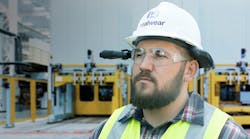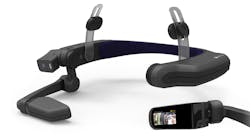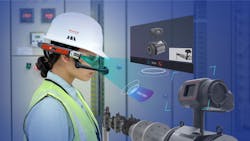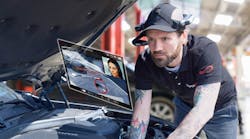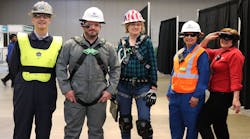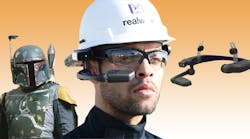Crowning Achievement: This Industrial Wearable Reigns Supreme
The age of the connected industrial worker has been a long time coming. It began in the 1990s, the availability of affordable mobile technology that wirelessly linked people across the plant around the world. Gradually, over the last two decades, the Industrial Internet of Things has allowed greater numbers of machines to communicate with each other almost instantaneously. The logical next step for manufacturers is to merge humans and machines.
And that time is now.
I’d love to tell you it’s because the Elon Musk-funded Neuralink brain chip for mind-melding with AI is finally commercially available (it’s not), or that we’re all about to enter the Matrix (that’s at least five years out), but the actual reason is much more realistic and easy to understand.
Plants, factories, and utilities finally have that killer (in a good way) human-machine interface that meets their stringent safety standards, withstands their harsh environments, and survives the scrutiny of their no-nonsense users: the RealWear HMT-1— the first and only industrial-grade, 100% hands-free wearable computer.
As Apple’s iPhone defined the form and function of smartphones everywhere, so too has this head-mounted tablet set the standard for industrial wearables.
Within the high-tech laurel wreath form factor, which can clip to a hardhat or bump cap, you’ll find everything you’d expect from a handheld tablet: an 8-core Snapdragon 625 chipset, an Android 6.0.1 operating system, a 16-megapixel camera (1080p video), a full suite of sensors (3-axis accelerometer, magnetometer, and gyroscope) and hot-swappable Li-Ion battery that lasts a full shift. An adjustable boom houses the monocular display, which appears as a 7-in. display relative to the eye. This can be used to play video, look at work instructions, or augment the worker’s environment in real-time.
RealWear has shipped 10,000 HMT-1 units in about 18 months, becoming the wearable of choice for harsh industrial applications.
The key differentiator from other mobile devices, aside from being worn on the head, is that not only is there no touch screen, but no need to touch anything. The voice recognition system responds swiftly to all commands, from recording video to contacting the control room. Even in a 95-dB environment, the system can pick up on voice commands. At launch, the system recognized verbal orders 24 out of 25 times.
Swiping a tablet can be just as speedy as talking, but for industrial workers that’s not the case.
“You can do some jobs twice as fast as you can with a tablet,” says RealWear CEO Andy Lowery. “And manufacturing time can be reduced as much as 55% from a traditional paper and pencil way."
In that case, a tablet was 10-20% less efficient, he says.
Currently, RealWear has gained about 800 enterprise customers since becoming available in July 2017. With more than 10,000 units shipped, including 200 to the world’s largest utility (State Grid in Shanghai, China), the Vancouver-based RealWear, Inc. has risen to the top of the industrial wearable world.
By operating the HMT-1 with their voices, workers at height can focus on holding ladder rungs or tools, not an inspection camera or radio.
The new intrinsic model, the HMT-1Z1, is being considered or deployed at every major oil & gas provider, while companies such as Honeywell have integrated it with their own software platform Movilizer and rolling it out by the dozens. Last October, Colgate Palmolive announced it has concluded pilot programs at eight sites and hundreds of mechanics and engineers across 20 facilities would use the HMT-1.
Having personally tested the device last year (video at bottom of story) , the reason for the rapid growth is apparent: it’s as easy and intuitive to operate as an iPhone.
“We’re simpler than Apple,” asserts Lowery about the HMT-1 user experience.
That’s fair, as I am an Android user and still don’t get the nuances of the Home button. With the HMT-1, just say “back.” You want to select an app, just tilt your head its way.
And getting new applications for data visualization or remote guidance via the RealWear Foresight Cloud is like clicking on the App Store to find a new game or streaming service. Enterprises and third-party developers can also create their own apps. And when you want to launch one, even if your hands are holding open a machine door or squeezing through an access tunnel, all you have to do is say the word.
“Our users need that kind of simplicity because they don’t want to be bogged down with a bunch of digital hoops and ladders,” Lowery says. “They just want the information there.”
Data Drive
Obtaining that info is more of a requirement in this time of digital transformation. Data can uncover greater efficiencies, better productivity, hidden areas of waste. It drives overall continuous improvement, it steers capital investment, it directs change. There’s rarely a manufacturing narrative that doesn’t mention data nowadays.
And now the conversation has turned to empowering workers with that data. According to Accenture, 94% of industry executives consider connected workers essential to their future with about one in five implementing measures to connect them. What is actually being connected though?
Lowery points out all the sensor-loaded pumps and valves, motors and heat exchangers are feeding temperature, pressure and flow data to an insatiable cloud, where algorithms scour for actionable data, ways to preempt catastrophes—maybe detecting a bearing screech and historically relating that to an impending pump failure.
He equates this predictive maintenance practice of forecasting critical equipment failure to “looking for canaries,” which makes sense, “because when those things break, they bring down a whole plant,” he says.
This is why connecting the worker to the data via the wearable interface is so important to Lowery; it catalyzes the data into action.
Miners wouldn’t just stand around and watch the canary asphyxiate; they would start moving.
“It matters not one hill of beans until you can get that information and turn it into knowledge for the worker, who can actually click that pump off and bring another pump on or replace the bearings,” Lowery says.
His own data insights, from his time as a Naval officer operating and maintaining an aircraft carrier’s nuclear reactors, helped him glean the importance of actionable data. Back then it was created by steam and turbine generators, the various reactor control equipment.
“Every single one of them had a material history book that I could go through and look at all the data, all the trend analysis, all the different things that basically went on in the history of that,” the retired lieutenant commander explains. “But guess how many times we did that proactively? Zero!”
With the HMT-1, you can’t help but see the data when it’s even clearer than the nose on your face. And it’s not one logbook worth of data, but the company’s entire repository of information, linked wirelessly to the data historian and ERP. It’s compatible with every major software provider, from Schneider Electric to Emerson to PTC. And workers can’t put it down, and likely won’t want to. It also has manufacturers on the prowl for new places for it to drive value.
It’s one thing to fix that pump when you know it’s about to break. It’s another to guarantee the maintenance was done correctly and the equipment is functioning. Lowery says the HMT-1 has reduced errors by “800 times in some cases.”
This can be achieved simply by having the work instructions always visible, by getting assistance from an expert watching the video feed, or from the QR codes on the machine triggering AR data visualization.
SAFETY FIRST
Errors are still bound to happen. Maybe not with repairs, but someone or something somewhere is going to mess up. They always do. Luckily, the entire hands-free platform is centered around safety and agility, every design feature handy for some intensive industrial use. It fits comfortably with standard PPE, such as safety glasses and a hard hat, and the device’s rugged shell allows it to survive a 2-meter drop onto concrete (not exactly a standard iPhone feature).
Also, important: it is comfortable and light enough (380 g) to be worn all day, making compliance more likely. And you can reverse the boom arm so the display isn’t always in your peripheral vision.
For serious danger zones, there’s the HMT-1Z1, which can be deployed in potentially explosive or flammable environments including oil & gas facilities, flour factories, and pharmaceutical factories, the last of which would become highly explosive in the event of an oxygen leak.
A worker can plug a thermal camera into the micro-USB port of the HMT-1 and start recording a daily thermal video diary. It’s just easier to have that always running and an algorithm scanning for patterns and possible signs of hot spots than relying on a handheld thermal camera, Lowery says.
“Leaky flanges can spew out this very fine mist—gasoline vapor that no one can see with the naked eye, but in the thermal domain you can,” Lowery explains. “So, before it even gets bad, you can spot the pinhole leak you need to tighten down.”
SAVING STEPS
Sanjay Jhawar, RealWear co-founder and president, estimates about 100 million workers in manufacturing and the service industry worldwide use their hands.
“Our strategy is really a 10-year penetration of those 100 million users,” Jhawar says. Already, pilot time has dropped from about nine months to four.
Productivity isn’t only driven by keeping their hands free. Cutting down on legwork can be just as beneficial, according to Jhawar.
One food and beverage manufacturer, which has a state-of-the-art control room with wall-to-wall 4K monitors streaming 1,000 data points, did not have data readouts on the industrial frying machine making the snack product. The oil temperature and purity had to remain consistent, requiring new supply that then had to be reheated on a frequent basis. The operator at the machine relied on radio prompts from the control room operator to know when the correct temperature was reached. Sometimes, they worked alone and had to walk the 200-meter span, check the data and come back to adjust.
“During that time, the fryer would produce 200 kilos of snacks that may have to be scrapped,” Jhawar says. “That’s like half a dumpster.”
The solution was to place QR codes on the machines connected to the data historian. The worker saves times, burning less product (and fewer calories).
Of course, untold walking can be reduced through wearable computers’ most well-known use case: remote expertise. RealWear calls itself a knowledge transfer company and this is a big reason why. An equipment specialist can stay in the control room, or their living room, and guide a service technician at the scene to troubleshoot or repair equipment. They can even channel their inner-Madden and telestrate the problem, like circling a bent bracket.
It can turn an hour of downtime into 15 minutes and makes the ROI almost immediate in some cases, Jhawar says.
“These things pay for themselves in a single use,” he says. The HMT-1 is around $1,500 and the HMT-1Z1 just shy of $5,000, not including integration costs.
STRIKING OIL
The value of cutting down on the number of employees needed for a job or speeding up their task time does not compare to the oil & gas industry’s need for a reliable wearable HMI.
If you’re able to get a wheel platform pump back up and running in six days instead of 12, “you just made yourself $3 million more dollars in revenue,” Lowery says.
That’s an extreme example, but any manufacturer stands to benefit by avoiding downtime.
“If a critical pump goes down, it may shut the whole operation down,”Texmark Chemical CEO Dough Smith says. “If we can predict that, we see great cost savings.”
And if they can prevent it from happening, in part by connecting their workers, at the very least Texmark found it can lower its insurance deductible.
When its insurance carrier asked for an enhanced and formalized mechanical integrity program, and doubled the deductible as an “incentive,” Texmark began a digital transformation, working with HP, PTC, and a consortium of other software providers to become the Refinery of the Future, serving as an example for the oil & gas industry to follow. The HMT-1Z1 was the only suitable option to connect workers, and gather real-time critical asset data and personnel health and safety stats.
Several pilots and applications have been deployed, including using it to precisely turn manual valves and as a replacement for a broken intrinsically safe camera to document that train car valves are properly sealed when leaving the yard, says Kelly Ireland, founder and CEO of the primary project integrator CB Technologies.
After using it during the pilot project, Ireland says the worker was incapable of parting with it.
“I will never give this helmet up,” she recalls him saying. It is now part of the the standard operating equipment.
Ireland, who has been in IT for more than four decades had a similar reaction when she tried it.
“I put the helmet on and I instantly started working through the application,” she says. “I was absolutely floored. This is going to make your job easier, safer more productive.”
At Texmark, it was part of a strategy that has reduced planned maintenance costs by 50% and led to the insurance carrier not only returning to the original rate but asking about getting other clients to adopt their technology.
It proves even the biggest companies are still searching for solutions, for the right way to leverage the best practices of yesterday with the cutting-edge methods of tomorrow. If almost every exec wants connected workers and only 21% have them, that's a lot of uncharted territory.
Lowery believes his is the platform on which new solutions can be found, at least for now. Like the iPhone, it doesn’t inherently offer any answers; it's merely a conduit for them, a gateway to industrial know-how and experience.
“What it does is provide the simplest, easiest, safest way to get that knowledge into those frontline workers so they can effect change” Lowery says.
Here's RealWear CEO Andy Lowery walking us through how to use the HMT-1.










